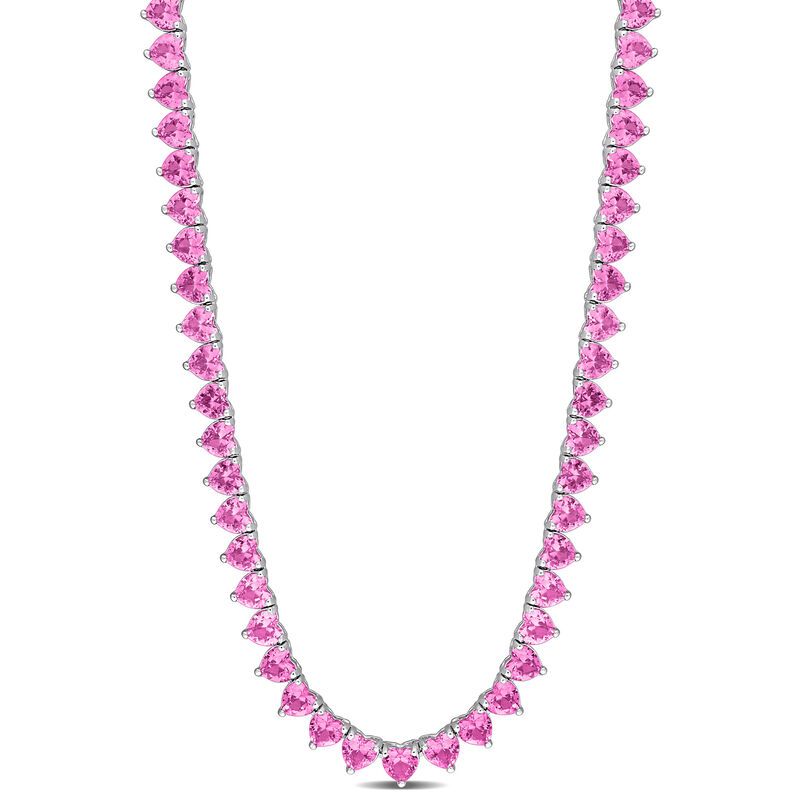Understanding Pink Sapphire Tennis Necklaces
A pink sapphire tennis necklace is characterized by a continuous, flexible strand of individually set pink sapphires. This design exudes elegance and offers a sophisticated display of color and brilliance, making it a highly sought-after piece of fine jewelry.
Key Attributes of Pink Sapphires
Pink sapphires, a variety of the mineral corundum, are prized for several key characteristics:
- Color Spectrum: The hue of pink sapphires can range from delicate, pale pinks to vibrant, intense magentas. The saturation and uniformity of color are critical determinants of their beauty and value. Subtle secondary tones, such as purplish or orangey tints, can also influence their appeal.
- Durability: With a Mohs hardness rating of 9, sapphires are exceptionally durable, second only to diamonds. This makes them well-suited for the repeated wear associated with a tennis necklace.
- Clarity: While inclusions are natural in sapphires, eye-clean or near eye-clean stones are preferred. The type, size, and location of inclusions affect transparency and overall value.
- Treatments: Heat treatment is a common and widely accepted practice to enhance the color and clarity of pink sapphires. Disclosure of any treatments is standard gemological practice.
Necklace Design and Construction
The construction of a pink sapphire tennis necklace involves meticulous attention to detail:

- Setting Styles:
- Prong Setting: The most common style, allowing maximum light exposure for enhanced brilliance. Typically uses three or four prongs per stone.
- Bezel Setting: Offers a modern look and superior protection by encircling the sapphire with metal.
- Stone Cut: Round brilliant cuts are frequently used to maximize sparkle. Oval, cushion, and princess cuts are also popular choices, depending on the desired aesthetic.
- Metal Choices: Common metals include 18k or 14k white gold, platinum (for its hypoallergenic properties and durability), rose gold (which complements the pink hue), and yellow gold (for a classic contrast).
Factors Influencing Value
The overall value of a pink sapphire tennis necklace is determined by several interconnected factors:
- Color Quality: This is paramount. Intense, vivid, and evenly saturated pinks command the highest prices. The “purity” of the pink, without undesirable brownish or grayish modifiers, is key.
- Clarity Grade: Higher clarity (fewer and less visible inclusions) significantly increases value.
- Cut Precision: A well-executed cut enhances the sapphire’s brilliance and light return. Poorly cut stones will appear dull, regardless of color or clarity.
- Carat Weight: Both the total carat weight of all sapphires and the size of individual stones are important. Larger individual sapphires of high quality are rarer and more valuable.
- Stone Matching: Uniformity in color, saturation, cut, and size across all sapphires in the necklace is crucial for a harmonious and high-quality appearance.
- Origin: While quality is the primary driver, sapphires from certain renowned localities (e.g., Sri Lanka, Madagascar) may carry a premium.
- Craftsmanship: The quality of the metalwork, setting security, and overall finish of the necklace.
Care and Maintenance
To maintain the beauty of a pink sapphire tennis necklace:
- Regular Cleaning: Use warm water, mild dish soap, and a soft brush. Rinse thoroughly and dry with a soft, lint-free cloth.
- Professional Cleaning: Ultrasonic and steam cleaners are generally safe for un-fracture-filled or heat-treated sapphires. However, consult a professional jeweler, especially if the clarity characteristics are significant or if other treatments are present.
- Avoid Harsh Chemicals: Exposure to harsh chemicals can damage the metal or potentially affect treated stones over time.
- Proper Storage: Store separately in a fabric-lined jewelry box or pouch to prevent scratches from other jewelry.
- Periodic Inspection: Have a jeweler check the settings annually to ensure all stones are secure and that prongs have not worn down.




















